
Illiopolis is a village in Sangamon County, Illinois, United States. The population was 891 at the 2010 census. It is part of the Springfield, Illinois Metropolitan Statistical Area.

An oil refinery or petroleum refinery is an industrial process plant where petroleum is transformed and refined into products such as gasoline (petrol), diesel fuel, asphalt base, fuel oils, heating oil, kerosene, liquefied petroleum gas and petroleum naphtha. Petrochemical feedstock like ethylene and propylene can also be produced directly by cracking crude oil without the need of using refined products of crude oil such as naphtha. The crude oil feedstock has typically been processed by an oil production plant. There is usually an oil depot at or near an oil refinery for the storage of incoming crude oil feedstock as well as bulk liquid products. In 2020, the total capacity of global refineries for crude oil was about 101.2 million barrels per day.

Propylene oxide is an acutely toxic and carcinogenic organic compound with the molecular formula C3H6O. This colourless volatile liquid with an odour similar to ether, is produced on a large scale industrially. Its major application is its use for the production of polyether polyols for use in making polyurethane plastics. It is a chiral epoxide, although it is commonly used as a racemic mixture.

The Flixborough disaster was an explosion at a chemical plant close to the village of Flixborough, North Lincolnshire, England, on Saturday, 1 June 1974. It killed 28 and seriously injured 36 of the 72 people on site at the time. The casualty figures could have been much higher if the explosion had occurred on a weekday, when the main office area would have been occupied. A contemporary campaigner on process safety wrote "the shock waves rattled the confidence of every chemical engineer in the country".
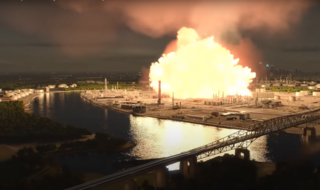
A boiling liquid expanding vapor explosion is an explosion caused by the rupture of a vessel containing a pressurized liquid that is or has reached a temperature sufficiently higher than its boiling point at atmospheric pressure. Because the boiling point of a liquid rises with pressure, the contents of the pressurized vessel can remain a liquid as long as the vessel is intact. If the vessel's integrity is compromised, the loss of pressure drops the boiling point, which can cause the liquid to convert to gas expanding rapidly. BLEVEs are manifestations of explosive boiling.
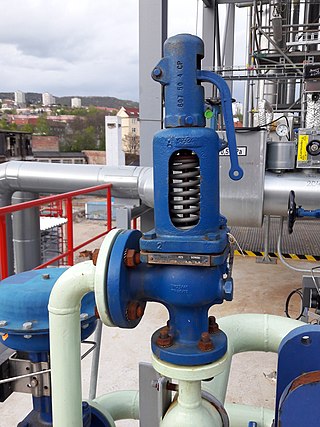
A relief valve or pressure relief valve (PRV) is a type of safety valve used to control or limit the pressure in a system; excessive pressure might otherwise build up and create a process upset, instrument or equipment failure, explosion, or fire.

The Texas City refinery explosion occurred on March 23, 2005, when a flammable hydrocarbon vapor cloud ignited and violently exploded at the isomerization process unit of the BP oil refinery in Texas City, Texas, killing 15 workers, injuring 180 others and severely damaging the refinery. All the fatalities were contractors working out of temporary buildings located close to the unit to support turnaround activities. Property loss was $200 million. When including settlements, costs of repairs, deferred production, and fines, the explosion is the world's costliest refinery accident.
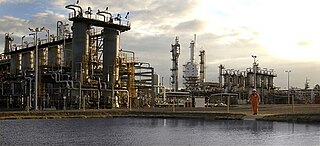
On 25 September 1998 a catastrophic accident occurred at the Esso natural gas plant in Longford, Victoria, Australia. A pressure vessel ruptured resulting in a serious jet fire, which escalated to a conflagration extending to a large part of the plant. Fires lasted two days before they were finally extinguished.

A combustible material is a material that can burn in air under certain conditions. A material is flammable if it ignites easily at ambient temperatures. In other words, a combustible material ignites with some effort and a flammable material catches fire immediately on exposure to flame.
Process safety is an interdisciplinary engineering domain focusing on the study, prevention, and management of large-scale fires, explosions and chemical accidents in process plants or other facilities dealing with hazardous materials, such as refineries and oil and gas production installations. Thus, process safety is generally concerned with the prevention of, control of, mitigation of and recovery from unintentional hazardous materials releases that can have a serious effect to people, plant and/or the environment.
On 23 October 1989 at approximately 1:05 PM Central Daylight Time, a series of explosions occurred at Phillips Petroleum Company's Houston Chemical Complex (HCC) in Pasadena, Texas, near the Houston Ship Channel. The initial blast registered 3.5 on the Richter scale, and the resulting fires took 10 hours to bring under control, as efforts to battle the fire were hindered due to damaged water pipes for the fire hydrants from the blast. The initial explosion was found to have resulted from a release of extremely flammable process gasses used to produce high-density polyethylene, a plastic used for various consumer food container products. The US Occupational Safety and Health Administration fined Phillips Petroleum Company $5,666,200 and fined Fish Engineering and Construction, inc, the maintenance contractor, $729,600. The event killed 23 employees and injured 314.
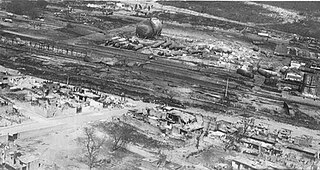
The San Juanico disaster involved a series of fires and explosions at a liquefied petroleum gas (LPG) tank farm in the settlement of San Juan Ixhuatepec, a municipality of Tlalnepantla de Baz, State of Mexico, Mexico, on 19 November 1984. The facility and the settlement, part of Greater Mexico City, were devastated, with 500–600 victims killed, and 5000–7000 suffering severe burns. It is one of the deadliest industrial disasters in world history, and the deadliest industrial accident involving fires and/or explosions from hazardous materials in a process or storage plant since the Oppau explosion in 1921.

The Feyzin disaster occurred in a refinery near the town of Feyzin, 10 kilometres south of Lyon, France, on 4 January 1966. An LPG spill occurred when an operator was draining water from a 1,200m³ pressurised propane tank. The resultant cloud of propane vapour spread, until it was ignited by a car on an adjoining road. The pool of propane in the bund caused the storage tank to be engulfed in flames, which produced a Boiling Liquid Expanding Vapour Explosion (BLEVE) when the tank ruptured. This resulted in a fireball which killed and injured firemen and spectators. Flying missiles broke the legs of an adjacent sphere which later BLEVE'd. Three further spheres toppled due to the collapse of support legs which were not adequately fire protected. These vessels ruptured but did not explode. A number of petrol and crude oil tanks also caught fire. The conflagration took 48 hours to bring under control. This incident resulted in the deaths of 18 people, the injury of 81 and extensive damage to the site.
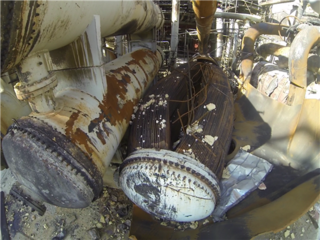
The Williams Olefins Plant explosion occurred on June 13, 2013 at a petrochemical plant located in Geismar, an unincorporated and largely industrial area 20 miles (32 km) southeast of Baton Rouge, Louisiana. Two workers were killed and 114 injured. The U.S. Occupational Safety and Health Administration (OSHA) and the U.S. Chemical Safety and Hazard Investigation Board (CSB) launched investigations to determine how and why the heat exchanger failed. The Chemical Safety Board concluded that a standby heat exchanger had filled with hydrocarbon. This heat exchanger was isolated from its pressure relief; shortly after the heat exchanger was heated with hot water, the hydrocarbon flashed to vapor, ruptured the heat exchanger, and exploded.
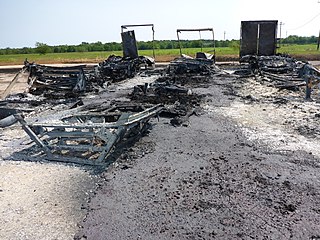
The 2017 Arkema plant explosion was an industrial disaster that took place during Hurricane Harvey in Crosby, Texas. Flooding from the hurricane disabled the refrigeration system at the plant which manufactured organic peroxides. The unrefrigerated organic peroxides decomposed and self-ignited.
On January 24, 2020, a building at Watson Grinding and Manufacturing in northwest Houston, Texas, United States, exploded at 4:24 a.m. Debris was scattered as far as one-half mile (0.8 km), and approximately 200 nearby houses and businesses were damaged. Officials asked local residents to search for debris and body parts to assist with an investigation into the explosion's cause. An absence of zoning ordinances separating industrial areas from residences is known to prevail in the vicinity of the explosion.

A domino effect accident is an accident in which a primary undesired event sequentially or simultaneously triggers one or more secondary undesired events in nearby equipment or facilities, leading to secondary accidents more severe than the primary event. Thus, a domino effect accident is actually a chain of multiple events, which can be likened to a falling row of dominoes. The term knock-on accident is also used.
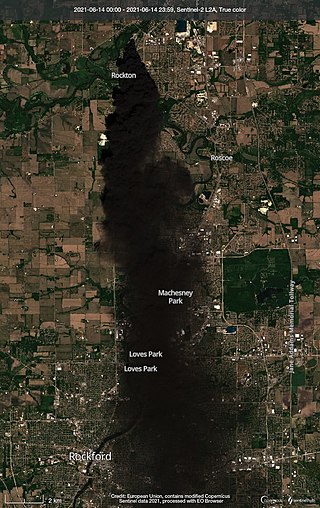
On June 14, 2021, a maintenance accident at the Chemtool Incorporated manufacturing plant in Rockton, Illinois, United States, triggered a chemical fire that lasted four days and injured two emergency workers. Portions of the village, located north of Rockford near the Illinois-Wisconsin state line, were subject to a mandatory evacuation as a result of the fire. The fire was not contained until June 16, with the evacuations lasting until June 18.
An explosion at the ARCO Chemical (ACC) Channelview, Texas petrochemical plant killed 17 people and injured five others on July 5, 1990. It was one of the deadliest industrial disasters in the history of the Greater Houston area.

In the early morning of June 21, 2019, a fire and multiple explosions occurred at the Philadelphia Energy Solutions (PES) refinery in Philadelphia, Pennsylvania. A release of hydrocarbons and hydrofluoric acid in the refinery's alkylation unit caused a ground-hugging vapor cloud which rapidly ignited, leading to three separate explosions minutes apart from each other. The largest explosion, a BLEVE, sent a vessel fragment flying 2,000 feet (610 m) across the Schuylkill River. Five employees sustained minor injuries, but there were ultimately no fatalities. The refinery announced it would shut down operations the same month, and filed for bankruptcy a month later.

















